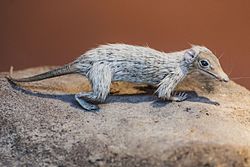Megazostrodon
|
Megazostrodon Temporal range: Late Triassic–Early Jurassic |
|
|---|---|
 |
|
| Megazostrodon model, Natural History Museum, London | |
| Scientific classification | |
| Kingdom: | Animalia |
| Phylum: | Chordata |
| Order: | Therapsida |
| Suborder: | Cynodontia |
| Family: |
†Megazostrodontidae Gow, 1986 |
| Genus: | †Megazostrodon |
| Type species | |
|
Megazostrodon rudnerae Crompton & Jenkins, 1968 |
|
Megazostrodon is an extinct Mammaliaform that is widely accepted as being one of the first mammals and which appeared in the fossil record approximately 200 million years ago. It did have some non-mammalian characteristics but they were sufficiently minor to warrant the analysis that this animal probably represents the final stage of the transition between cynodonts and true mammals.
Megazostrodon was a small, furry,shrew-like animal between 10 to 12 centimetres (3.9 to 4.7 in) long which probably ate insects and small lizards. It is thought that it was nocturnal as it had a much larger brain than its cynodont relatives and the enlarged areas of its brain were found to be those that process sounds and smells. This was probably in order to avoid being in competition with the reptiles or becoming prey to the dinosaurs.
Megazostrodon is the only well-known genus of the family Megazostrodontidae. The other members of this family that are currently known to science are Indozostrodon, Dinnetherium, Wareolestes and Brachyzostrodon. The megazostrodontids used to be classified as members of a group of mammals called the Triconodonts, which are thought to have evolved from a specific group of reptiles (the cynodonts or 'mammal-like reptiles’) during the late Triassic and early Jurassic periods. However, recent classifications consider the megazostrodontids to be mammaliaforms just outside the Mammalia proper, while the triconodonts remain in the (crowngroup) Mammalia. One must keep in mind that the distinction between true mammals and mammaliaformes is purely a cladistic and phylogenetic one: mammaliaforms are mammals in every other way.
These early mammals developed many traits which were to make them well-suited for a very active lifestyle. They developed four types of teeth (as opposed to the uniform teeth of the reptiles), incisors, canines, premolars and molars, which enabled them to chew and therefore process their food more thoroughly than their reptilian cousins. There is evidence that the inward-closing movement of the mandible suggests a shearing action to chew food. Their skeletons changed so that their limbs were more flexible (they became less laterally splayed, allowing for faster forward motion) and they developed a shorter ribcage and larger lungs to allow for faster respiration. The structure of their jaw bones changed, the lower jaw becoming a single bone — the dentary (as opposed to the seven different bones found in reptilian lower jaws). The other bones which once made up the jaw moved to the middle ear to create a hearing system.
...
Wikipedia
